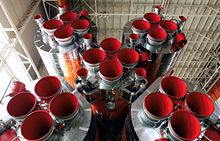Sixty years ago on October 4th, the Soviet Union launched Sputnik, the first artificial Earth satellite, and triggered the Space Race between the U.S. and the U.S.S.R. The Sputnik satellite was sent into orbit by a Soyuz rocket. Since that historical launch, the Soyuz family of rockets was the workhorse for the Soviet space program, and, since the fall of the U.S.S.R. in 1991, has been the workhorse for the Russian space program. Soyuz rockets are the only launch vehicles that are currently sending payload to the International Space Station. The Russian also still use the heavy-lift Proton rocket developed by the Soviets in the 1960s to launch commercial satellites into high-Earth orbit.
These two families of Soviet/Russian launch vehicles have an excellent reputation from decades of use. However, lately, their legendary reliability has suffered. A series of recent failures raises the question of whether or not the plant in Voronezh that produces rocket engines for the Soyuz and Proton rockets is able to maintain the high level of quality control that is required for these engines to function properly.
Problems with Soyuz and Proton engines in 2016 were found to be the result of manufacturing flaws at the Voronezh factory. Roscosmos, the Russian space agency, had to send over seventy rocket engines back to the factory to have faulty parts replaced. One result was a one year hiatus of Proton launches. This lack of launch capability has injured Russian status in the commercial satellite launch market. Last year was the first time that the U.S. and China both carried out more launches than Russia.
Many clients have chosen to have their satellites launched by SpaceX Falcon 9 rockets. SpaceX has managed to lower their launch costs by making their boosters reusable. The SpaceX Falcon Heavy-lifter will be tested this fall. It will be able to lift three times the load of any existing launch vehicle at one half the price.
While Russia is obviously aware of the fact that it is becoming uncompetitive in the commercial launch business, it is not clear what they intend to do about it. There have been reports that they may manufacture a lower-powered Proton engine in order to reduce costs.
The Khrunichev company which manufactures the Soyuz and Proton engines, is having serious difficulties. There have been criminal investigations of alleged mismanagement. A decision was made to sharply reduce its assets. A lot of the expensive real estate in western Moscow that belongs to the company is being slated for development.
Russia has been working on the Angara rocket which will be a replacement for both the Soyuz and the Proton. There have been repeated delays in the Angara project and questions have been raised about whether it will ever be finished. Without a long track record of successful launches and with a greater construction cost than other rockets in the commercial launch market, its prospects are dim.
The Russians will also be losing their monopoly for launches to the ISS soon. The SpaceX Dragon v2 and the Boeing Starliner crew capsules will be flying test missions to the ISS next year. The Russians have been working on the Federation which is a new crew capsule to replace the Soyuz capsule. A test flight has been tentatively scheduled for 2023 but there are few details available. Russia has also talked about sending manned missions to the Moon in the 2020s but little is known about those plans.
Soyuz rocket engines:
